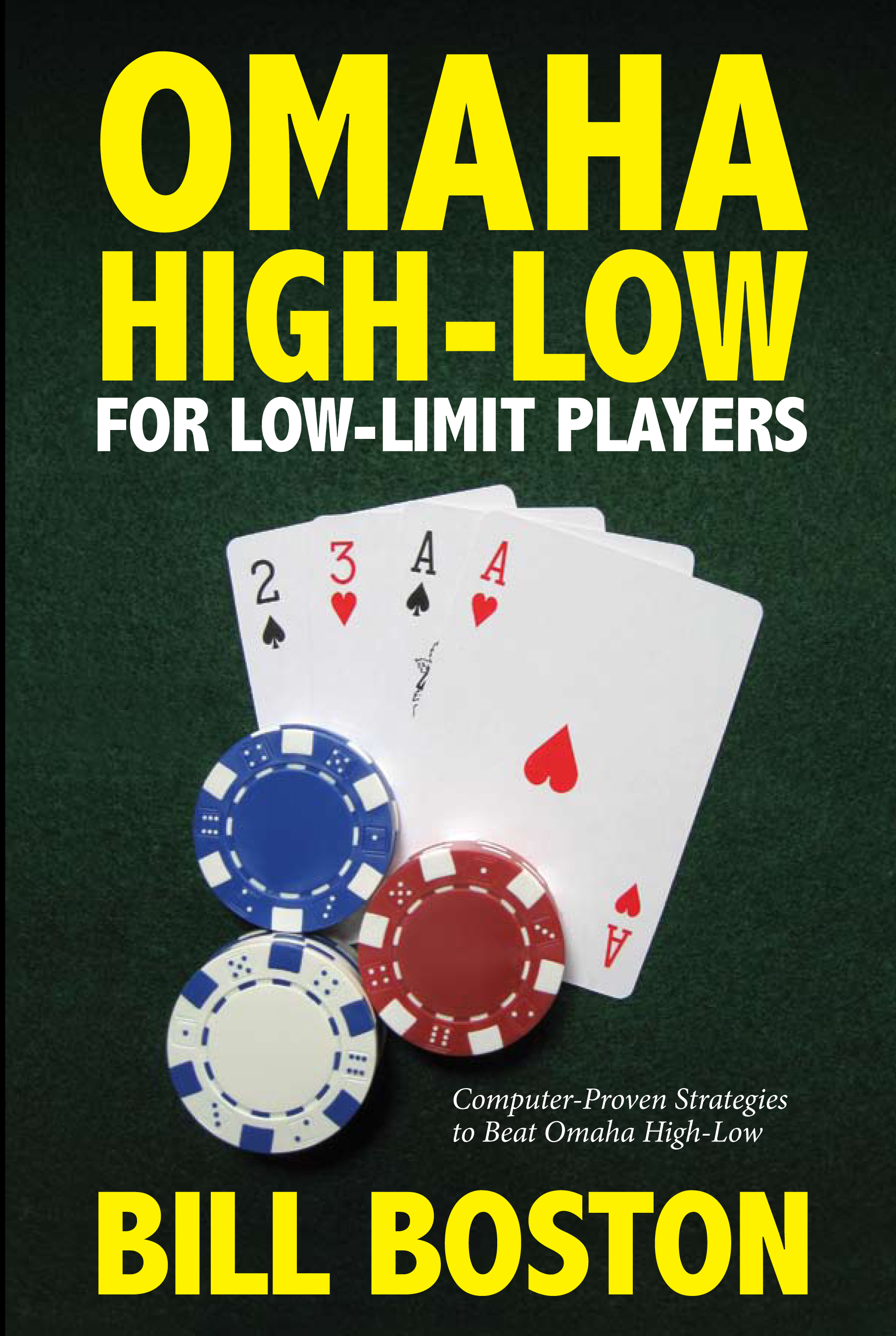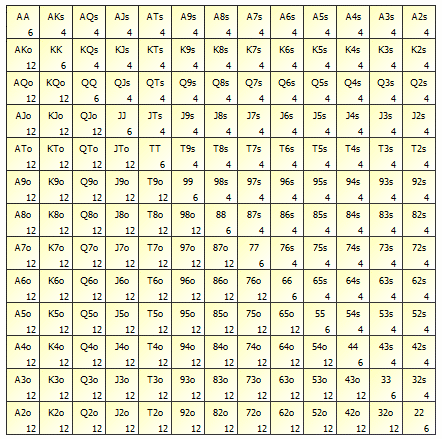
A lot of players start by playing the most popular form of poker, Texas Holdem and then after a while they take up Omaha Hi Lo for a different challenge.
In many ways, it is quite easy for Holdem players to migrate to Omaha as it is also part of the Holdem family of games, and the underlying principle of each player being dealt cards and then combining those cards with the cards dealt to the centre of the table throughout the hand is the same across the family of games.
Omaha Hi Lo introduces two simple differences in that each player gets dealt 4 hole cards of which 2 must be used in their final hand with the other 3 being taken from the community cards in the centre.
Even if it is a multi-way pot, you will often get quartered. This is particularly true if you are going for the low half. If you are going for the low half, you can easily get counterfeited and lose the entire pot. The negative effects of playing for half are amplified in PLO8 compared to other split pot games because it. Omaha Hi Lo 8b Strategy Omaha Hi Lo (also known as Omaha 8 or Omaha Eight or Better) is a “split pot” version of the popular Omaha poker game. In this version of the game, there are two winning hands in each round: the high winner and the low winner. Omaha Hi/Lo Strategy Omaha Hi/Lo (8 or better) is currently the most popular split-pot poker game in the world. It is important to understand the rules of Omaha before playing Omaha Hi/Lo. While Omaha is very similar to Texas Hold'em, many new Omaha players get confused by the 'must use two hole cards and only two hole cards' rule. Omaha Hi-Lo Strategy Omaha Hi-Lo Split is a variation of Omaha that can have a “low” hand as well as the usual “high” hand. The player must be able to make a five-card “low” hand to qualify. Your objective with every hand you play in Omaha Hi-Lo are twofold, to ‘scoop’ both the high and the low sides of the pot and to avoid being quartered – these objectives must be considered every time you enter a pot if you are to be a long-term profitable player.
The other difference is of course the pot being split into two with half being awarded to the best hand from the low poker hand ranking as long as a player holds a qualifying low hand with 5 different cards all 8 or below. The remaining half (or the whole pot if not qualifying low hand) is awarded to the player with the best high hand, which is the more familiar high hand rankings used in Texas Holdem.
Although getting off the ground and understanding the basic principles of how to play Omaha Hi Lo isn’t too difficult, it is a very different game to master and play well. Many players continue to play Omaha, but don’t understand the different strategy required to actually win consistently.
So here I am going to outline the top 10 mistakes that you must avoid if you want to become a winning Omaha Hi Lo player.
1. Misreading Your Hand
This is probably the most common mistake I see made. Any hand in Omaha must consist of exactly 2 cards from your hole cards dealt to you plus 3 cards from community cards dealt in the centre.
The number of times a player thinks they have a straight or flush, but then realise that actually they are counting 3 of their hole cards, or 4 of the community cards and actually it is not a legal Omaha hand.
Make sure that you are using the correct number of cards from each source, and avoid making costly mistakes of calling to the river only to find that the hand you were relying on is fake.
2. Bluffing like it’s Texas Holdem
You have realise in Omaha there are a lot more hand combinations out there. Each player has more cards dealt to them (4) and hence there are more opportunities to make good hands. Often Omaha is referred to as a game of draws, as more than likely in every hand there will be lots of players on draws to very strong hands.
This means that it is very often going to take a very strong hand to rake in a pot, someone generally has the nuts (best possible hand) too.
Bluffing players and getting them to fold therefore gets much harder when they have big draws. Certainly much harder to do than in Texas Holdem. Not to say that you shouldn’t bluff in Omaha, but opportunities are rare and generally best identified by more experienced players.
3. Drawing to the “Non Nuts”
Another common mistake is players see a draw to a good hand that they can make and plough money into the pot chasing that draw only to realise that an opponent was drawing to a much better hand.
Here are just a few examples of sure fire ways to leak money in Omaha Hi Lo:


- Drawing to the second or third best Low hand (opponent with a better Low hand)
- Drawing to straights and flushes on a paired board (opponent with a full house)
- Drawing to non-nut flushes (opponent with the nut flush)
4. Lack of Patience
A tight / aggressive approach is generally a winning strategy at Omaha Hi / Lo. Most players are capable of playing in this manner for short periods of time, but when good starting hands start to go bad and draws start to miss things can go amiss.
It is key to keep a long term focus when at the tables and not let yourself loosen up too much. One bad session can undo hours of hard work and toil, don’t let that be you.
Omaha High/Low has a slow hand rate because of its complicated and loose nature, a winning player will fold a lot of starting hand combinations as well as fold after a lot of flops that don’t fit their hand. If you are not willing to have the patience to wait out extended periods of inaction and you lack discipline then Omaha High / Low is not your game.
5. Miscounting Outs
The counting of outs becomes more complicated in Omaha High/Low than in other community card games. The fact that the pot is often split, must factor into your calculation of how much your outs are actually worth.
Yes, if you hit your flush you have the nut high hand, but if the flush card makes a low possible you are only going to win half the pot a lot of the time. It must also be considered that even if you make the nut hand on the turn, an opponent may redraw on the river either to take the low, capture the high or both.
6. Not Playing The Situation
At lower limits, Omaha Hi Lo games can be beaten by following rigid starting hand requirements and post-flop analysis.
However, as the limits get higher, the players get better and this strategy becomes less effective. The number of players in the pot, the looseness of the game, the aggressiveness of it’s players are just some of the factors that more advanced players start to consider.
All these factors and more have to be considered in order to adapt your strategy to the situation at the table. This may be different from session to session.
7. Overplaying Big Pairs
Players that covert from other flop games, such as Texas Holdem tend to overvalue big pairs that are dealt to them and get very excited when they see a pair of Aces or Kings in their Omaha hand dealt to them.
With 4 hold cards dealt to each player you will be dealt high pocket pairs more often, but also they are devalued because there is a higher likelihood of an opponent making a better hand such as trips, a straight, a flush etc.
The other problem that arises with big pair hands is that with no decent low to go along with them, such as with hands like A-A-J-8 and K-K-T-2, it is rare that these hands can scoop the low hand pot as well as the high hand pot.
Big pairs struggle hold up to win the high side of the pot at the best of times, and with no low cards it is impossible scoop if a low is present.
8. Playing for Half the Pot
When three low cards flop and you don’t have any decent low in your hand, it is usually incorrect to continue in the hand without a very strong high hand.
Flopping a set (three of a kind) in this situation usually warrants a fold, something that Texas Holdem converts struggle with at first. Needless to say, in these situations you should avoid continuing with high draw hands unless the pot odds warrant.
The same thinking applies to nut low draws when you don’t have any high hand or high hand draw of substance. For example, many poor players continue with a hand like A-2-7-J when the flop is something like 8-5-K.
Playing for half the pot against just one or two opponents, means you are essentially playing just to try and win the money you have put into the pot back, and that is the best case scenario, break even. Worst is you don’t even win half the pot and lose the extra money you have had to put in to get to the end of the hand.
9. Raising Out Callers With A One-Way Lock
When you have a hand where you have a lock on one half of the pot, but no real claim to the other half of the pot it is sometimes in your best interests to play it more passively and keep players involved in the hand.
If you are fairly sure you will be splitting the pot, the more callers, the larger the half of the pot that you lay claim to. Contrasting this, if you believe that other players are weak and a bet or raise can take down the whole pot, you should do so.
However, many players who are starting out exercise poor judgement and tend to raise out potential value from the hand through their over eagerness.
10. Tilt
In Omaha Hi Lo, particularly fixed limit where you can’t effectively raise out draws, you are going to get sucked out on a lot. If this is something that you struggle to deal with, and tend to go on Poker Tilt a lot, then Omaha Hi Lo is going to be a real grind for you, and probably is best avoided.
Additionally, no pre-flop hand is a big favourite over another and even the best of starting hands can, and regularly do, get beaten. The ability to remain in control of your emotions and stay off tilt is key to winning at Omaha Hi Lo.
Steps to Success
If followed, those 10 quick tips can bring you real success in Omaha Hi Lo. Some regular players believe it is an easier game to beat than Texas Holdem, as there are many inexperienced players who don’t fully understand good Omaha Strategy. With your head start, you can now also take advantage of these players also.
Trust & Security
I'll only recommend Safe & Trusted sites with a proven track record
By Game Type
Different rooms are better for different game types & stakes
Beginner Friendly
I'll find you a site with players of a similar skill level
Promotions
I'll find you the best value Promotions, Bonus & Freebies!
Posted by Evans Clinchy, February 10, 2015
If you’ve spent some time dabbling in various poker games, you’ve no doubt learned the basics of Omaha – you get four hole cards, share five community cards, and form the best five-card hand possible using two from your hand and three from the board. But Omaha Hi Lo is a much trickier game. You’re playing for a split pot, with half the money going to the best hand and the other half to the lowest five cards (with 8 being the highest possible value of those 5 cards).
It’s a complex game to be sure, but if you spend some time brushing up on Omaha Hi Lo advanced strategy, you might find that playing the game at the top level is a lot of fun – and mighty profitable, too! Professional poker player Sammy Farha has won two Omaha Hi Lo bracelets at the World Series of Poker, earning almost $900,000. You could follow in his footsteps.
Here are a few tips on playing Omaha Hi Lo like the pros.
Play for the Nuts
The golden rule of high-level Omaha Hi Lo is this: if you’re in the pot, you want to have the best possible hand. If you flopped a draw to the lowest possible straight, don’t bother sticking around. Your hand might get there, but you still could lose to the higher straight, wasting a whole lot of money in the process. Since everyone’s holding four cards, there’s that much more of a chance that everyone’s got something decent, so you shouldn’t mess around with suboptimal holdings. Even if you’re holding A-3 and thinking you’ve got a good shot at winning the low half of the pot, someone else is likely to have A-2, especially at a full table. Countless players have gone broke in Omaha Hi Lo with the second-best hand.
Embrace Drawing Hands
By the showdown you want to have the best hand, but on earlier streets you should learn to love playing with a draw. If you have K-5-4-3 and the flop comes A-2-J, you don’t have anything yet, as you can only use two cards from your hand, so you haven’t made a straight or a low. However, if the turn brings any three, four, five, six, seven, or eight, then, all of a sudden you’re in business. You might even actually be a favorite post-flop against an opponent with a made hand, even though all you currently have is king high! Bet with confidence.
Even Made Hands Are Risky
Keep in mind, though, that even if you’ve made your hand, you’re still not bulletproof. You might hit your straight, but your opponent could still have outs for a flush. Maybe you turned the flush, but the guy to your left with trips still has redraws to hit a full house. You could have the nut low with A-2, but if the river brings a deuce, then your low is “counterfeited” and your opponents with A-3 will “suddenly” have you beat. Perhaps your low will indeed be the nuts but someone else at the table also has the same hand, so instead of winning half the pot, you just get a quarter. Bottom line: Even with a great hand, you might be in trouble.

Be Ready to Gamble
Pot Limit Omaha Hi-lo Strategy

The beauty – and at the same time, terror – of Omaha Hi Lo is that it’s a game of variance. When you’re risking a lot of money on drawing hands and your opponents are doing the same, you’re going to see some crazy swings in luck. You might find yourself winning and losing more in a single session than you ever did playing Texas Hold’em. But hey, that’s part of the game’s appeal. If you’re ready to get in there and gamble, Omaha Hi Lo might be the right game for you.
Play Omaha Hi Lo Poker at Titan Poker. Download and get into the action today!